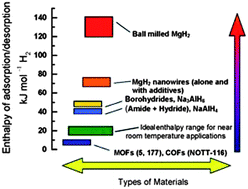Emerging concepts in solid-state hydrogenstorage: the role of nanomaterials design
Abstract
This perspective highlights the state-of-the-art solid-state

* Corresponding authors
a
West CHEM, School of Chemistry, Joseph Black Building, University of Glasgow, Glasgow, UK
E-mail:
Duncan.Gregory@Glasgow.ac.uk
Fax: +44 (0)141 330 4888
Tel: +44 (0)141 330 6438
b EADS Innovation Works, Energy& Propulsion, 81663 Munich, Germany
c Department of Chemistry, Indian Institute of Technology Roorkee, Roorkee 247667, Uttarakhand, India
This perspective highlights the state-of-the-art solid-state

 Please wait while we load your content...
Something went wrong. Try again?
Please wait while we load your content...
Something went wrong. Try again?
H. Reardon, J. M. Hanlon, R. W. Hughes, A. Godula-Jopek, T. K. Mandal and D. H. Gregory, Energy Environ. Sci., 2012, 5, 5951 DOI: 10.1039/C2EE03138H
To request permission to reproduce material from this article, please go to the Copyright Clearance Center request page.
If you are an author contributing to an RSC publication, you do not need to request permission provided correct acknowledgement is given.
If you are the author of this article, you do not need to request permission to reproduce figures and diagrams provided correct acknowledgement is given. If you want to reproduce the whole article in a third-party publication (excluding your thesis/dissertation for which permission is not required) please go to the Copyright Clearance Center request page.
Read more about how to correctly acknowledge RSC content.
 Fetching data from CrossRef.
Fetching data from CrossRef.
This may take some time to load.
Loading related content
